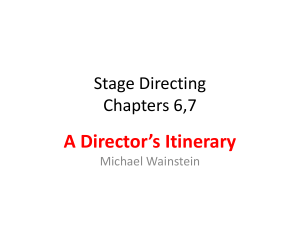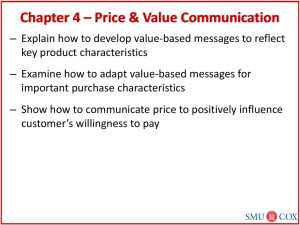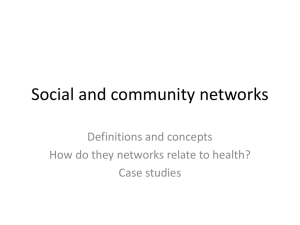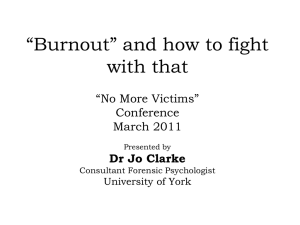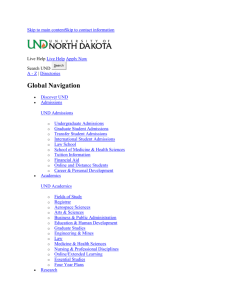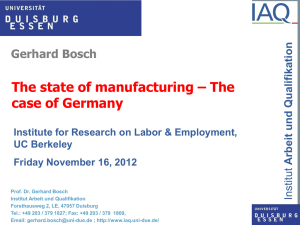Work stress
advertisement
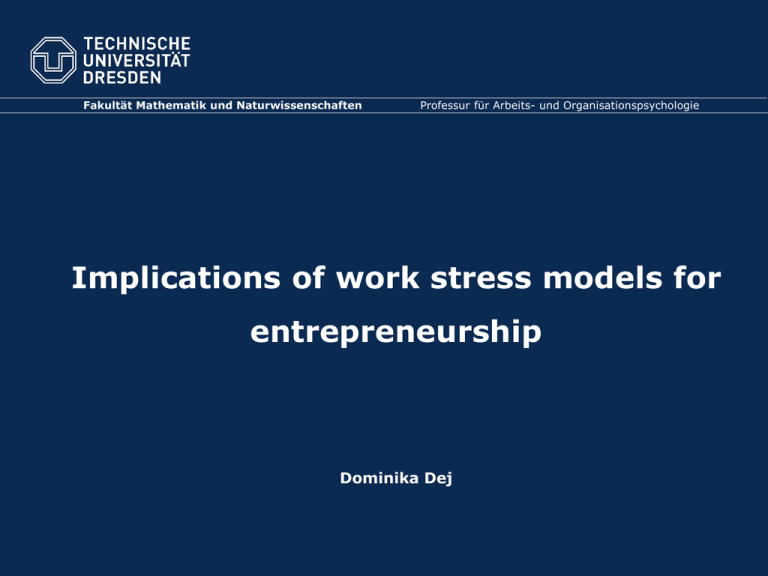
Fakultät Mathematik und Naturwissenschaften Professur für Arbeits- und Organisationspsychologie Implications of work stress models for entrepreneurship Dominika Dej Today‘s agenda • Importance of work for human beings • Film • Work stress models • Work Design Questionnaire (WDQ) • Your Job Fit • What is good work? Importance of work for human beings We spend half of our adult life at work • It can be a joy or a chore • A source of… Meaning, purpose, satisfaction, solace, inspiration, connection OR Frustration, dissatisfaction, alienation The importance of work What do psychologists say? “Work will always matter to people … they will always love it and hate it … society should help people love it more than hate it.” Warr & Wall (1975, p. 11) What is good work? Specialization and simplification • Your reflection about the film… • Past or maybe future? http://www.youtube.com/watch?v=CYbsBcPDVQM Specialization and simplification Old way: Assembly at individual stations People hate simplified work • Importance of social relationships/ social connection New way: ? Health, learning, personality development Work stress models: Basic definitions Definition of job demands “The degree to which the environment contains stimuli that peremptorily require attention and response. Demands are the ‘things that have to be done.’’ Jones & Fletcher (1996, p. 34) “Job demands are those physical, psychological, social, or organizational aspects of the job that require sustained physical and/or psychological (i.e., cognitive or emotional) effort and are therefore associated with certain physiological and/or psychological costs. Although job demands are not necessarily negative, they may turn into job stressors when meeting those demands requires high effort and is therefore associated with high costs that elicit negative responses such as depression, anxiety, or burnout.“ Schaufeli & Bakker (2004, p. 296) Work stress models: Basic definitions Definition of job resources “Job resources refer to those physical, psychological, social, or organizational aspects of the job that either/or (1) reduce job demands and the associated physiological and psychological costs (2) are functional in achieving work goals (3) stimulate personal growth, learning and development. Schaufeli & Bakker (2004, p. 296) Hence, resources are not only necessary to deal with job demands and to ‘get things done,’ but they also are important in their own right“ (Hobfoll, 2002). Work stress models: Exercise emotional cognitive physical others Job resources - - - - Job demands - - - - Definition: Job Demands and Job Resources Job demands are those physical, psychological, social, or organizational aspects of the job that require sustained physical and/or psychological (i.e., cognitive or emotional) effort and are therefore associated with certain physiological and/or psychological costs. Although job demands are not necessarily negative, they may turn into job stressors when meeting those demands requires high effort and is therefore associated with high costs that elicit negative responses such as depression, anxiety, or burnout.“ Job resources refer to those physical, psychological, social, or organizational aspects of the job that either/or (1) reduce job demands and the associated physiological and psychological costs (2) are functional in achieving work goals (3) stimulate personal growth, learning and development. Vitamin Model (Warr, 1994) • Mental health is affected by environmental psychological features (e.g., job characteristics) in a way that is analogous to the effects that vitamins are supposed to have on physical health • There are 9 vitamins = job characteristics that influence the psychological work-related health Vitamin Model (Warr, 1994) 6 vitamins (job characteristics) have curvilinear effects on health, i.e. both lack of and excess of such features will affect mental health negatively: 1. Opportunity for control 2. Opportunity for interpersonal contact 3. Opportunity for skills use 4. Externally generated goals 5. Variety 6. Environmental clarity. 3 vitamins have a linear effect on health, i.e. the higher such a job characteristic, the higher the level of mental health will be: 1. Availability of money 2. Physical security 3. Valued social position. Vitamin Model (Warr, 1994) • Affective well-being is a principal indicator for job-related mental health. Job-related affective well-being has generally been studied in terms of job satisfaction, job-related anxiety, or tension, occupational burnout, and depression. Warr proposes three dimensions for this purpose: displeasure-to-pleasure, anxiety-to-comfort, and depressionto-enthusiasm. • Three categories of individual characteristics are viewed as moderators: values, abilities, and baseline mental health “concept of match“ for job characteristics, individual characteristics, and mental health (e.g., the relationship of job control and satisfaction will be higher for a person with a high preference for autonomy than for one with a low preference for autonomy) Question: Is there a linear relationship between job characteristics and mental health? Vitamin Model (Warr, 1994) Work Design Questionnaire (WDQ) Identified 18 dimensions; 4 major categories –Task –Knowledge –Social –Contextual • Measured work characteristics with 540 job incumbents across 243 different jobs What is the relationship between a diverse set of work features and outcomes? What is the relationship between a diverse set of work features and outcomes? What is the relationship between a diverse set of work features and outcomes? What is good work? Where is the person in this? • Fit for the work – Demands-abilities – Needs-supplies – Satisfaction of preferences/ values What is good work? The Status of “Good Work”? • This is a complicated thing • Good for who? • Good for what? – Satisfaction, stress, performance, OCB • Too much of a good thing? How to Foster Good Work? Workers can play a central role in “sculpting” or “crafting” their jobs – They enact their roles in slightly different ways, expanding it beyond formal boundaries – Individuals as active job (re) designers… • What are the antecedents of different forms of role expansion? Who is Responsible for Good Work? Many responsible parties – Workers: Be open and proactive – Leaders: Understand worker needs, help design work, allow variation where possible – Organizations: Culture, supportive systems – Society: Laws, regulations, activists, social organizations • Bad work is often the result of a flawed assumption about the purpose of organizations The pursuit of economic outcomes is not necessarily the primary goal of business The Purpose of Organizations “I think many people assume, wrongly, that a company exists simply to make money. While this is an important result of a company’s existence, we have to go deeper and find the real reasons for our being…we inevitably come to the conclusion that a group of people get together and exist as a company so that they are able to accomplish something collectively that they could not accomplish separately–they make a contribution to society, a phrase which sounds trite but is fundamental.” David Packard, Founder, HP We have a responsibility as psychologists to help ensure good work… Thank you! My thanks to Prof. Fred Morgeson for the use of certain slides from his presentation “Who is Responsible for Good Work?“ (EAWOP 2011) Certain images sourced from Google Images. Literatur Bakker, A.B., & Demerouti, E. (2007). The Job Demands-Resources model: State of the art. Journal of Managerial Psychology, 22, 309-328. DUNCKEL, H. (1999). Handbuch psychologischer Arbeitsanalyseverfahren. Zürich: vdf HACKER, W. (1995). Arbeitstätigkeitsanalyse. Heidelberg: Asanger HACKER, W. (2005). Allgemeine Arbeitspsychologie. Bern: Huber HACKMAN, J. R., & OLDHAM, G. R. (1980). Work Redesign. Reading, MA: Addison-Wesley. JOHNSON, J. V., & HALL, E. M. (1988). Job strain, work place social support, and cardiovascular disease: A crosssectional study of a random sample of the Swedish working population. American Journal of Public Health, 78, 1336-1342. KARASEK, R. A. (1979). Job demands, job decision latitude, and mental strain: Implications for job redesign. Administrative Science Quarterly, 24, 185-308. LE BLANC, P., DE JONG, J., & SCHAUFELI, W. (2008). Job Stress and Occupational Health. In ? NACHREINER, F. (2008). Erfassung psychischer Belastung und Rückwirkung auf die Arbeitsgestaltung. Leistung und Lohn. Z. f. Arbeitswirtschaft NEBEL, C., WOLF, S., & RICHTER, P. (2009). Instrumente und Methoden zur Messung psychischer Belastung. In Windemuth, D., Jung, D., & Petermann, O. (Hrsg.), Praxishandbuch psychischer Belastungen im Beruf. Wiesbaden: Universum Verlag RICHTER, P. (2006). Occupational Health Psychology (OHP) – Gegenstand, Modelle, Aufgaben. In WITTCHEN, H. U., & HOYER, J. (Hrsg.), Klinische Psychologie & Psychotherapie. Heidelberg: Springer RICHTER, P., & HACKER, W. (1998). Belastung und Beanspruchung – Streß, Ermüdung und Burnout im Arbeitsleben. Heidelberg: Asanger SARGES, W., & WOTTAWA, H. (2004). Handbuch wirtschaftspsychologischer Testverfahren. Band I: Personalpsychologische Instrumente. Lengerich u. a.: Pabst SARGES, W., WOTTAWA, H., & ROOS, Ch. (2010). Handbuch wirtschaftspsychologischer Testverfahren Band II: Organisationspsychologische Instrumente. Lengerich u. a.: Pabst SIEGRIST, J. (1996) Soziale Krisen und Gesundheit. Hogrefe, Göttingen SIEGRIST, J. (1996). Adverse health effects of high effort–low reward conditions. Journal of Occupational Health Psychology 1, ? SIEGRIST, J., & PETER; R. (1996). Measuring Effort-Reward Imbalance at Work: Guidelines. Institut für Medizinische Soziologie, Düsseldorf. STROHM, O., & ULICH, E. (1997). Unternehmen arbeitspsychologisch bewerten – Ein Mehr-Ebenen-Ansatz unter besonderer Berücksichtigung von Mensch, Technik und Organisation (MTO). Zürich: vdf ULICH, E. (2005). Arbeitspsychologie. Stuttgart/Zürich: Poeschel/vdf

